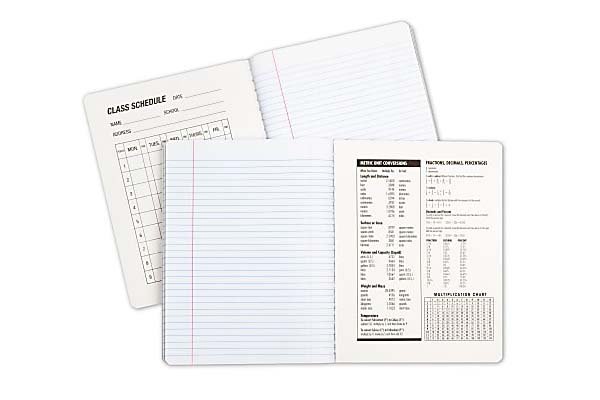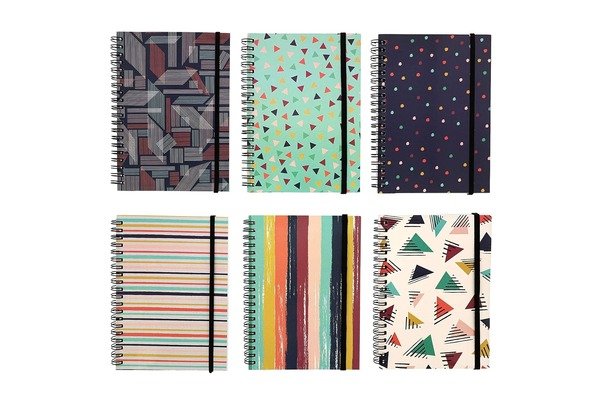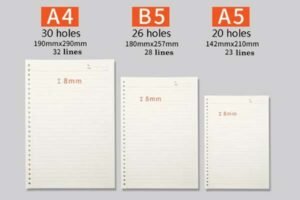
Are you confused by notebook page count1s? Choosing the wrong one can affect your writing experience. This guide will make it simple for you to pick the perfect notebook.
A standard notebook typically has between 160 and 200 pages. For instance, many everyday notebooks offer 192 pages. However, this count can vary a lot depending on the notebook's intended purpose and design.
This range from 160 to 200 pages is a sweet spot for many users. It offers enough space for daily notes or journaling without being too bulky. But this is just a general guideline. At NotebookRing®, we manufacture notebooks with a wide variety of page counts. The final number depends on factors like size, binding style, and intended use. For example, a pocket notebook will have fewer pages than a large academic planner. We help our clients find the perfect balance for their specific needs, from design to production.
We see different standards across different notebook types2. Pocket notebooks, designed for portability, might have only 64 to 100 pages. Standard A5 or B5 notebooks, perfect for daily use, often fall in that 160 to 200-page range. Larger notebooks for academic or business use can have 250 pages or more to handle extensive projects. Ultimately, the "usual" number changes based on who will be using the notebook and for what purpose. It is all about matching the tool to the task.
What is a “page”? How is page count calculated?
You see "pages" on notebook labels, but what does it really mean? Let's break down this basic but important term and how we count them in the industry.
A page is one side of a sheet of paper inside a notebook. So, one physical sheet of paper always contains two pages: a front page and a back page. The total page count is simply double the number of sheets.

This concept is fundamental in the stationery industry. Understanding it helps you know exactly how much writing space you are getting.
The Front and Back Rule
Think of a book you are reading. Every time you turn a leaf of paper, you have gone through two pages. The same logic applies to notebooks. The number printed on the sheet, if any, often corresponds to the page number. So, the first sheet of paper is page 1 on the front and page 2 on the back. This is a universal standard in printing and binding.
How We Calculate at NotebookRing®
As a manufacturer since 2006, precision is key for us. When a client like Sarah from a German bookstore chain requests a 200-page notebook, we know she needs exactly 100 sheets of paper. This calculation is crucial for managing material costs, production timelines, and ensuring the final product meets her specifications. Our four-level quality inspection includes verifying this count to a ±3% tolerance.
Here is a simple table to show the relationship:
| Number of Sheets | Number of Pages |
|---|---|
| 50 | 100 |
| 80 | 160 |
| 100 | 200 |
| 125 | 250 |
How many sheets of paper equal how many pages?
Let's get straight to the math. How do you convert sheets to pages and back again? It is simpler than you think once you know the rule.
The formula is very direct: one sheet of paper always equals two pages. This is because each sheet has a front side and a back side, and both can be used for writing. This rule never changes in notebook manufacturing.
This simple two-to-one ratio is the backbone of notebook production. It removes any confusion when we discuss product specifications with our clients.
A Simple Formula
To find the number of pages, you just multiply the number of sheets by two.
Number of Sheets x 2 = Number of Pages
To find the number of sheets, you divide the number of pages by two.
Number of Pages / 2 = Number of Sheets
It is that straightforward.
Why This Matters for Custom Orders
This calculation is especially important for our clients. When James from a Singaporean gifting company asks for a 300-set order of notebooks with "around 150 pages," we can clarify that he means 75 sheets. This precision helps manage the notebook's thickness, weight, and overall cost. For another client, Yuki's designer brand in Japan, we developed an ultra-thin planner. Knowing the exact sheet count was critical to keeping the thickness under 8mm, even with over 200 pages, a feat we accomplished with specialized binding.
Why do some notebooks say "40 sheets" and others say "80 pages"?
Have you ever noticed one notebook advertised by its sheets and another by its pages? This can be confusing, but there is a simple reason for it.
Both "40 sheets" and "80 pages" describe the exact same amount of paper. Companies choose one term over the other based on marketing strategy or regional norms. "80 pages" often sounds like more, which can be a marketing advantage.

The choice between listing "sheets" or "pages" is often a conscious business decision. It is not meant to deceive, but rather to align with customer expectations or marketing goals.
Marketing Perspective
From a marketing standpoint, a bigger number can seem more appealing. "80 pages of writing space" may sound more substantial to a customer than "40 sheets of paper." This is a common tactic in retail to emphasize the product's value. It highlights the total usable surface area for writing.
Industry and Regional Norms
The preferred terminology can also vary by region or product type. In the U.S. market, spiral-bound notebooks for school are often sold by their sheet count (e.g., "70 sheet college-ruled notebook"). However, in European and Asian markets, bound journals and business notebooks are more commonly advertised by their page count. At NotebookRing®, we export to over 60 countries, so we are flexible and use the terminology that best suits our client's target market.
What to Look For as a Buyer
As a buyer, just remember the 1 sheet = 2 pages rule. Whether it says 50 sheets or 100 pages, you are getting the same notebook. Focus on the number and do the simple math if you need to compare products.
Do the cover and back cover count as pages?
A common question we get is about the covers. Do the front and back covers add to the total page count listed on the packaging? Let's clear that up.
No, the front and back covers are never included in the official page count. The page count refers exclusively to the inner paper sheets intended for writing, drawing, or planning. The covers are considered part of the binding and exterior.

It is important to distinguish between the components of a notebook. The cover and the inner pages serve different functions and are accounted for separately in production.
Defining the "Inner Pages"
The "inner pages" or "text block" is the collection of sheets that make up the inside of the notebook. This is what the page count refers to. The cover's job is to protect these pages. The cover material is also usually much thicker and different from the inner paper. For example, we offer options like cloth hardcover or bagasse fiber for covers, which are distinct from the inner writing paper.
What About Endpapers?
In some casebound or hardcover notebooks, you might find endpapers. These are the sheets of paper glued to the inside of the cover. Typically, these are also not included in the page count, as they are part of the book's construction, not the writing block.
Our Standard at NotebookRing®
When we specify a notebook has 200 pages, we mean it contains 100 sheets of writing paper inside the cover. The cover, binding, and any accessories like bookmarks or elastic bands are separate components. This ensures clarity and consistency for all our clients.
Is more pages always better? How to choose the right count?
It is easy to assume that a notebook with more pages is a better value. But more is not always better. Let's find the right count for your needs.
The ideal page count depends on your specific needs. More pages mean more writing space but also more weight and bulk. You have to balance longevity with portability. The right choice is the one that fits your lifestyle and purpose.

Choosing a notebook is a personal decision. The page count is a key feature that affects its usability every day.
Consider Your Purpose
Think about what you will use the notebook for. A daily journal needs many pages to last a year. A travel notebook should be thin and light. A project planner might need a specific number of pages to cover a project's timeline.
We created a simple guide to help:
| Use Case | Recommended Page Count | Why? |
|---|---|---|
| Travel Journal | 60 - 100 Pages | Lightweight and easy to carry in a bag. |
| Daily Planner | 160 - 240 Pages | Provides enough space for a full year of planning. |
| Meeting Notes | 100 - 160 Pages | Portable enough for meetings, with ample space for notes. |
| Academic Notebook | 200 - 300+ Pages | Accommodates extensive notes for a semester. |
| Creative Sketching | 80 - 120 Pages | Balances portability with enough space for ideas. |
The Role of Paper Weight (GSM)
Paper thickness, measured in grams per square meter (gsm), also plays a role. Thicker paper, like the 100 gsm paper found in some premium notebooks, is great for fountain pens because it prevents ink from bleeding through. But thicker paper also means a thicker, heavier notebook. A 200-page notebook with 120 gsm paper will be much bulkier than one with 80 gsm paper. As a manufacturer, we offer our clients options. Upgrading from 80gsm to 100gsm might add only $0.07 per book but a significant change in quality.
Portability vs. Longevity
Ultimately, you must choose between portability and longevity. If you carry your notebook everywhere, a lower page count is better. If it stays on your desk, a higher page count is fine. There is no single "best" answer, only what is best for you.
Conclusion
Understanding page count is simple: one sheet equals two pages. The right number of pages for you depends on your purpose. Choose a notebook that balances portability with enough writing space, and you will have the perfect tool for your tasks.





